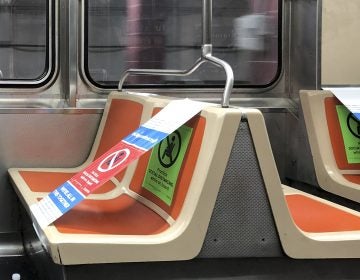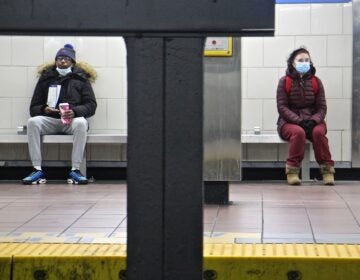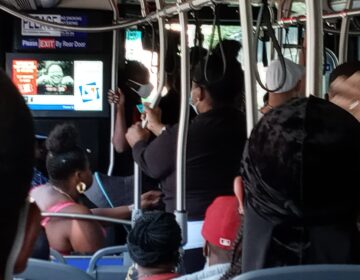Riding smart: SEPTA commuters take safety precautions amid coronavirus
As ridership numbers drop, the SEPTA riders left on emptier trains take up new safety practices.
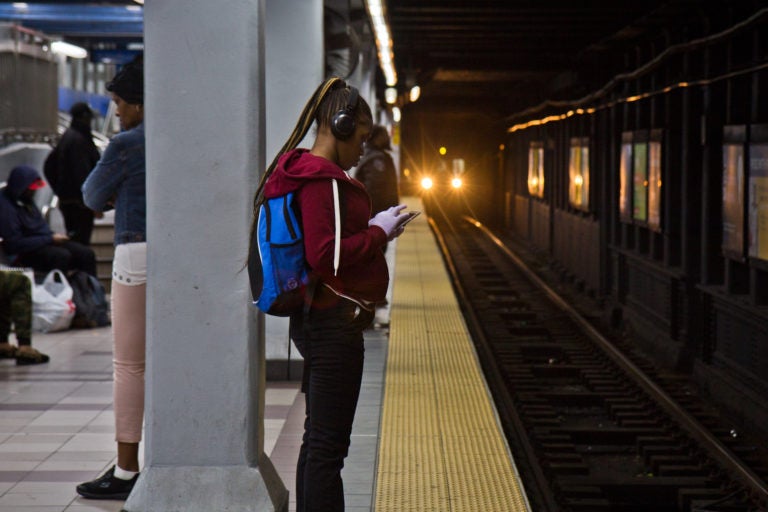
A rider waits for a SEPTA train. (Kimberly Paynter/WHYY)
Jenicia Smith takes the Market-Frankford Line to get to her food service job at Drexel University.
And as the coronavirus pandemic grows, so do the precautions she takes during her trip.
She said she tries “not to touch too many surfaces” and keeps a distance from people coughing or sneezing. When she gets to work, she washes her hands.
To get home, she takes Uber. She keeps hand sanitizer on her at all times, a pre-coronavirus habit, because “people do nasty stuff.”
The 29-year-old mother of two said her biggest concern is coming into contact with COVID-19 and becoming a carrier who will infect her children, or her mother, who has “a very low immune system.”
“It’s everywhere,” she said. “I don’t know. It’s unsafe everywhere.”
But as Smith and others brave the train to get to work, some in protective gear — including gloves — other riders are hunkering down or seeking less populous forms of transportation amid the outbreak.
After monitoring stations during rush hour Friday morning, SEPTA spokesperson Andrew Busch reported “a big difference from what we would be used to on a normal day.”
Subway and bus ridership dropped by 9% on Friday while Regional Rail saw a 16% decline, Busch said.
That decline was higher than the dips seen earlier in the week. SEPTA saw ridership drop by about 3% between Monday and Thursday. The decrease was expected, says Busch, as events get canceled, schools close and commuters stay home.
The authority also announced its March board meetings would be held via telephone, and closed to the public. Many members of the board generally commute to meetings by Regional Rail.
Busch said rider safety is the priority. But revenue officials are paying attention to the drop in farebox earnings.
“We’re too early on to know what the impact of that is going to look like,” Busch said. “But it’s definitely something that we’re tracking very closely and will continue to as this continues.”
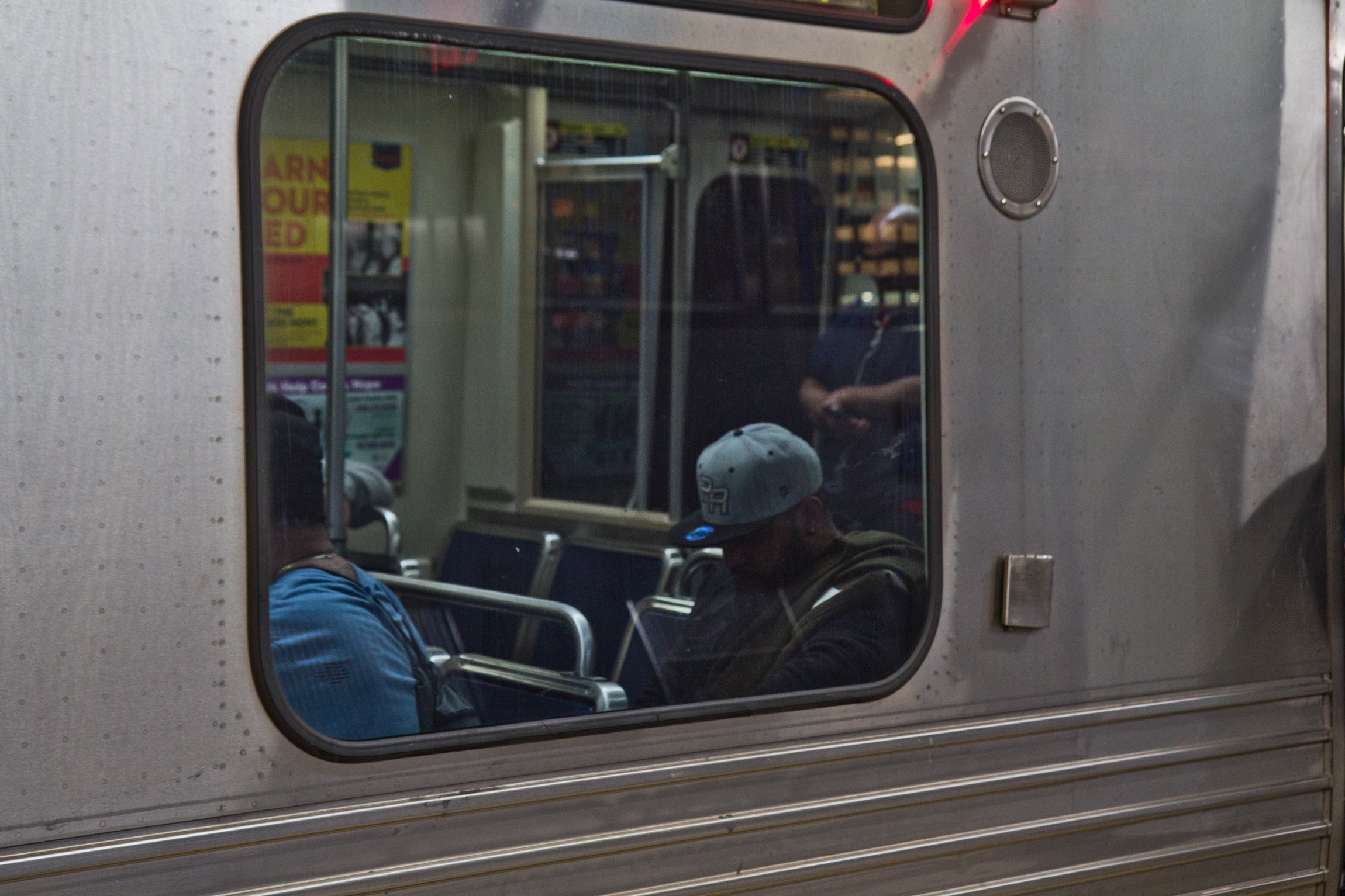
Philadelphia health officials have confirmed three COVID-19 cases in the city, with 62 cases being tested. The numbers are higher beyond city limits, with dozens of presumptive positive cases across the region in neighboring Pennsylvania counties and southern New Jersey.
PATCO, which connects Philadelphia to New Jersey, also saw a decrease of 6% between March 9 and 11. Meanwhile, NJ Transit ridership is down 20% in the last week, translating to about 164,000 fewer train and bus riders a day based on 2018 figures.
SEPTA instituted a new cleaning schedule to help slow the spread of the deadly virus. The authority says vehicles and stations are now being sanitized three times a day. The effort may lead to some permanent changes.
Still, some riders have reservations about entering the close quarters of transit vehicles as health officials advise to keep six feet away from other people, avoid coughing or sneezing on anyone and generally, avoid large crowds.
A 2011 study published in a peer-reviewed medical journal found that public transit use can increase a person’s risk of catching respiratory infection such as the flu or common cold. The study acknowledges that frequent riders regularly exposed to common viruses are more likely to develop immunity — but that isn’t the case for the novel coronavirus.
The risk to riders varies based on how close they are to other passengers, how long they spend on a train or bus, and ventilation, which must adhere to federal standards to reduce the spread of airborne illnesses.
Debating between if I should take the bus & subway - took both yesterday but weirdly things seem more serious today.
— jason n. peters (@JPeters2100) March 13, 2020
The information we’ve been given is so poor that idk what to do.
I usually ride my own bike anyway. In bad weather I’ll take the subway but homeward yesterday it was very crowded and that concerned me (I’m 67). Most likely will avoid it as a result.
— Andrew Ross (@aross2450) March 13, 2020
As SEPTA ridership losses, Indego, city’s bike-share, is seeing ridership spike. The blue bikes clocked about 14,000 rides the first nine days of March as the outbreak closed in on the city. That’s near twice the number of rides taken during the same period in 2019. While some users say concerns about coronavirus are inspiring them to travel by bike, the mild winter weather shouldn’t be overlooked as a contributing factor. The service was already seeing peak numbers for January and February.
I usually take the el/bsl from Fishtown to Point Breeze 3x/week. Now I'm avoiding peak hours and using Indego instead of transit when possible
— Will (@WillEvans215) March 13, 2020
I usually ride my own bike anyway. In bad weather I’ll take the subway but homeward yesterday it was very crowded and that concerned me (I’m 67). Most likely will avoid it as a result.
— Andrew Ross (@aross2450) March 13, 2020
New York City’s Metropolitan Transportation Authority is seeing a drop, too. MTA officials reported a decrease of about 19% in subway ridership and 13% in bus ridership on Wednesday.
Officials also reported massive drops in rail ridership Thursday. The Long Island Railroad decreased by 31% and the Metro-North by 48%.
NYC’s Department of Transportation reported a 56% surge over 2019 numbers on East River Bridges the first 10 days of March.
We've seen a surge in cycling since the beginning of March, with warmer temperatures and after recommendations from @NYCMayor and @nycHealthy regarding COVID-19. This week we've seen a 50+% increase in cycling on all East River Bridges (vs 2019).https://t.co/LU74aCrDf2 pic.twitter.com/fOxqT8idjr
— NYC DOT (@NYC_DOT) March 11, 2020
New York transportation advocates are seizing on the trend to call on city officials to implement more bike safety measures.
In Philadelphia, advocates are making similar calls.
Kelly Cofrancisco, spokesperson for the city’s Office of Transportation, Infrastructure, and Sustainability said the city has “no immediate plans for temporary street improvements.”
“We are monitoring the situation,” she said.
WHYY is your source for fact-based, in-depth journalism and information. As a nonprofit organization, we rely on financial support from readers like you. Please give today.




![CoronavirusPandemic_1024x512[1]](https://whyy.org/wp-content/uploads/2020/03/CoronavirusPandemic_1024x5121-300x150.jpg)
